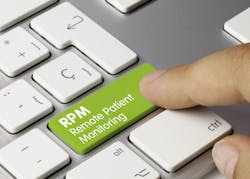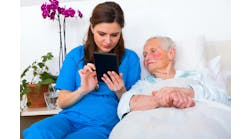One trend that has garnered considerable momentum from the pandemic involves moving care traditionally done in clinics and hospitals into patients’ homes. Innovations include telehealth appointments, acute hospital at home, hospice and palliative care at home, in-home health evaluations for Medicare Advantage, and remote patient monitoring for chronic conditions such as heart failure. The pandemic emergency has abated for now, but the interest in moving care into the home has not.
Because acute-care hospitals faced so many challenges from COVID-19, the Centers for Medicare and Medicaid Services (CMS) implemented the Acute Hospital Care at Home initiative to allow hospitals to expand their capacity to provide inpatient care in an individual’s home. Under the Consolidated Appropriations Act of 2023, the initiative has been extended through 2024, and hospitals can continue to apply to participate. But that means leaders of the hospital-at-home movement have relatively little time to conduct more studies to convince Congress of its efficacy and to make it permanent.
David Levine, M.D., M.P.H., M.A., attending physician and clinical director of research and development for Mass General Brigham Healthcare at Home, says that data is going to be important as this movement continues to progress. “Policymakers are requesting data, and rightfully so. It is really up to us to help create the evidence base, both for and against the model.”
Levine is one of the leaders of the Hospital at Home Users Group, a collaborative of hospital-at-home programs in the United States and Canada sharing resources and best practices. One of its initiatives is to create an agreed-upon minimum data set so as to create a voluntary registry of patients who have been cared for acutely at home. “We are asking members to contribute de-identified data into this research-grade registry. The beauty of that is it's going to include patients from all payers, not just Medicare fee for service,” he adds.
Creating that registry required determining which data elements to include. A workgroup made up of multidisciplinary experts came together to determine what the variables should be, and allowed for an open comment period before finalizing the variables. Sites are now being asked to start submitting their data.
CMS has said that state Medicaid programs can pay for acute hospital at home if they'd like to, and many have, Levine says, but there are still many states that haven't said whether or not they're going to pay for it. “We think it's another big opportunity to help to improve payment for the model. I think there are some Medicaid agency leaders who have probably still never even heard of home hospital and would be delighted to pay for it if they understood the model and the cost savings,” he adds. “They probably just have no idea that there's even a federal waiver for it.”
Levine says it is a little difficult to tell how much movement there has been on the commercial insurance front because our payment landscape is so fragmented and decentralized. “There are some markets that are really hot on home hospital right now commercial-wise, and there are others that are less so, but it's hard for me to make a generalization other than to say there are contracts coming in from commercial payers.”
Another aspect of maturity involves building program standards, and the H@H Users Group is developing such an initiative to say to health systems: Here is what we expect when you're delivering acute care at home. They have created Version 1.0 of their program standards. “We know that it will continue to evolve just like all standards do and should,” Levine says. “We are asking programs to identify the point person who will help to respond to the program standards inquiry.”
In the program at Mass General Brigham, Levine says, they are building “essentially an entire hospital worth of home hospital beds. It's very exciting to see this move to true scale. We have one of the biggest programs right now at a single site.”
Asked about the challenges around scaling up like that, Levine says the biggest one is staffing. “Everyone in healthcare says staffing is the biggest challenge,” he adds, “but it's actually very hard to hire an entire hospital's worth of nurses and doctors and paramedics that quickly, as well as all the administrators and coordinators to staff this up. The beautiful part is that you're not waiting for a building to get built or zoning regulations. The faster you can staff this thing, the more you're able to deploy it into the community.”
Potential of remote patient monitoring
New technologies are enabling chronic disease management programs to begin monitoring patients more closely in their homes. Levine notes those technologies can be over-hyped and that there is a dearth of well-done randomized controlled clinical trials of remote patient monitoring efforts that have demonstrated reduced readmissions or lower costs. The next step in the literature, he says, is to couple RPM with other beneficial and impactful interventions.
A September 2022 article in Health Affairs studied billing patterns for remote patient monitoring and agreed with Levine’s assessment that more studies are required. “Further research is needed to identify which patients benefit from remote patient monitoring, to inform evidence-based use and coverage decisions,” the paper said. “In the meantime, payers and policy makers should closely monitor remote patient monitoring use and spending.”
One recent study found that a remote hypertension program, operated by Mass General Brigham since 2019, successfully supported patients through the pandemic in achieving their blood pressure goals, with patients who enrolled during the pandemic reaching and maintaining their goal blood pressures an average of two months earlier than in the pre-pandemic period. The results, published in Journal of the American Heart Association, demonstrate the potential for remote programs to provide more effective and equitable care for hypertension, as well as other chronic conditions, the researchers said.
Steven Heatherly, M.D., medical director of heart failure and pulmonary hypertension at Baptist Health System, based in Louisville, Ky., is piloting capabilities to closely monitor patients with congestive heart failure in their homes, looking for improved outcomes more than cost savings.
“Heart failure patients are ideal for this because if you look at patients when they decompensate and they have a lot of fluid, the vast majority of them actually have a normal blood pressure. They don't require special IV medicines to keep those up, and they have fairly normal renal function,” Heatherly says. “Those are the two big issues where they might need to be in the ICU. It turns out that with the majority of patients, that's not the case. They have good blood pressures. They just have too much fluid in them. Treating them in an outpatient arena makes perfect sense. Also, of course, no one wants to go to the hospital. There are some negative things that happen when you get admitted. One of them is you're in the bed most of the time, so you get deconditioned. There are a lot of reasons why we want to do this more in a home setting or in a clinic if we can.”
Healtherly says monitoring patients and having more frequent touch points helps manage their conditions better. “We have found remote patient monitoring really increases clinic visits, and appropriately so. One of the secrets of heart failure discharges is that the overwhelming majority of patients are still volume-overloaded when they get discharged. They're not completely dried. The first week after a discharge, a patient may still need IV diuretics. What we found is remote patient monitoring helps us identify that cohort better so that we can call and have some touch points with them. One of our patients had to be diuresed five times over two weeks, and at each of those points, if it hadn't been for remote patient monitoring, she would have been in the ER, there's no question about it.”
A small pilot project that Baptist ran from December 2021 to September 2022 involved 41 patients who had just been admitted for heart failure. “The group was at such high risk that basically within 30 days, we were expecting about 18 percent of them to need a readmission,” Heatherly says. What we actually found was that we didn't have any readmissions for the 30, 60 or 90 days. So that was enough to pique my interest to look at this for other patients. The driver for that was increased clinic appointments. Based on vital sign readings, the Baptist team would reach out to them and figure out that they were decompensating again. “Then they would come in and get an IV diuretic. So that was the primary reason that worked,” he says.
Based on the results of that pilot, Baptist has started spreading the remote patient monitoring to other hospitals. “Not all of our hospitals have heart failure clinics, but right now we have six, and we are expanding the remote patient monitoring as we go,” Healtherly says.
Baptist worked with Current Health’s RPM solution for this because it had been chosen by the health system for other home care work with COVID patients. “One of the things we like about this system is that we get heart rate, saturations, skin temperature, weight, and blood pressures. Those are the things we look at for dosing, so that just made sense,” Heatherly says. “The feedback we're getting from patients is that it would be helpful for us to set it up for them in the home. Current Health has worked with the Geek Squad to set up equipment and that's something that we're going to look into.”
Baptist hasn’t waded into the payment issues around this effort yet. “When we decided to do our pilot and even now that we're launching in other markets, we still do this without charging,” Heatherly notes. “We're not submitting or collecting any billing for this, even though it is billable. We eventually will go down that route. We certainly don't want to leave money on the table, but that wasn't a priority for us. The thinking was more that this is working, so let's just keep launching it.”
There also is potential for using these tools for other conditions at Baptist Health. “It has been used in one of our other markets for COPD,” Heatherly says, “so now the question has come up whether we can do a disease-specific model with another disease. Diabetes and hypertension management have come up. We are focused on cardiovascular right now for obvious reasons. It's very prevalent. It affects many of our patients in Kentucky and Indiana, so I think we probably are going to look at doing something with COPD and probably diabetes and hypertension.”
Building up a virtual health program
Augusta University Health in Georgia is an example of a health system that had not been doing many virtual visits before the pandemic, but moved into virtual care out of necessity and has expanded its use since then. AU enrolled its first virtual care patient in February of 2021 to assist with reducing length of stay and helping to potentially avoid any readmissions for COVID-19 patients. It provided patients with a remote monitoring kit — a pulse ox, a thermometer and blood pressure cuff to go home with. Then its teams would monitor them 24/7. Patients would have a virtual visit with a healthcare provider at AU each day. “We would try to keep them out of the hospital and intervene by having them come to an outpatient clinic or doing a walk test at home to see if they needed home oxygen vs. bringing them back to the ER and having them wait or potentially expose others in the hospital to COVID,” explains Lauren Hopkins, assistant vice president of virtual care & community engagement at Augusta University Health.
“We were able to build confidence in the program gradually by having the hospitalist team work hand in hand with us. We started out with two or three patients with a hands-on approach, and with the physician leadership helping us ensure we're making the right decisions,” Hopkins says. “We tweaked our protocol several times before we really felt comfortable with it. As we provided feedback, showing the providers that we were reducing readmissions and the patients were really happy at home, it built their confidence up so that by the summer of 2021, we were running a census of 32 patients in this virtual care at home program. These patients were technically discharged from the hospital, but we were able to reduce their length of stay, get them out of the hospital early, and in some scenarios, avoid an unnecessary admission by directly enrolling them from the facility into this program, which really helped with throughput and bed capacity at the facility.”
Now AU has expanded the use of its virtual care program beyond COVID to other chronic conditions. “We have a pretty expansive list of conditions — anything from asthma exacerbation and pneumonia to pulmonary disease to heart failure and AFib,” Hopkins says. “Also, we are supporting post-surgical patients. We have enrolled some patients who had a surgery but did not meet inpatient criteria to stay in the hospital, so they came home in this program, and we monitored them. We're also doing other conditions such as diabetes, urinary tract infection and even sepsis.”
AU has started working with a company called Biofourmis that has several features the health system likes. No. 1 is the ability to do continuous monitoring. “What we had before was episodic,” Hopkins says. “We were calling a patient and saying don't forget to take your blood pressure or go get on that scale. Biofourmis helps eliminate some of the outreach efforts we were having to do previously to patients. By giving them a vitals wristband or armband, now we get that continuous information, so we don't have to necessarily wait until one o'clock in the afternoon to get vitals.”
Even though Augusta is the third-largest city in the state of Georgia, AU previously struggled with connectivity issues in some rural parts of the state. “Biofourmis embedded the video connectivity piece into the tablet,” Hopkins says. “It allowed a very seamless platform for the patient to take home a tablet, and have everything at their fingertips. The connectivity is improving. The video quality is better and the ease of connecting and talking to patients has also improved.”
AU also was accepted into the CMS acute care hospital at home waiver program in August 2022. “However, we were the first hospital in the State of Georgia to receive that waiver,” she says. “We are working with the Department of Community Health in the State of Georgia to ensure that we can meet the state's Conditions of Participation to enroll patients.”
Another goal for AU is to integrate data from the virtual care monitoring program into the EHR. “As we continue our partnership with Biofourmis, we want to have that information integrated into the EHR, so it is very seamless for our physicians, whether it's the provider seeing the patient that day, or maybe they're going to their cardiologist for a follow-up appointment,” Hopkins says. “Now that cardiologists can see all of that home monitoring information right there in front of them without having to log into a separate platform. That is definitely one of our long-term objectives.”


